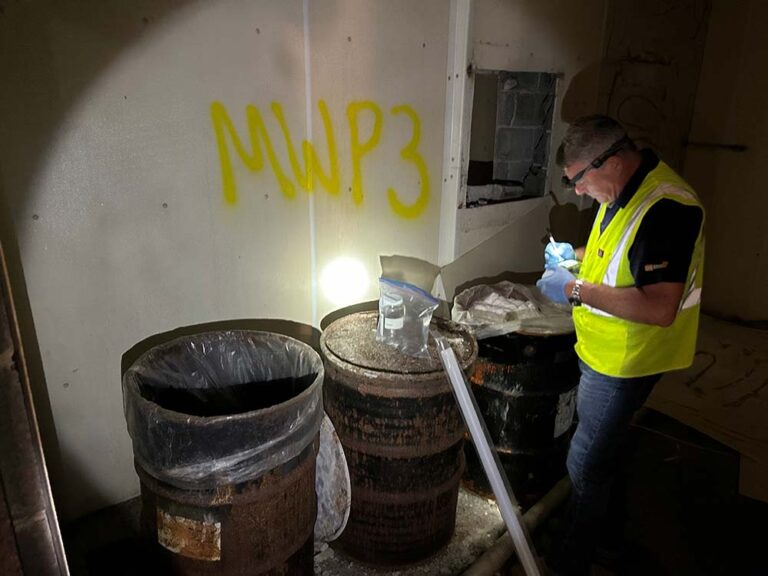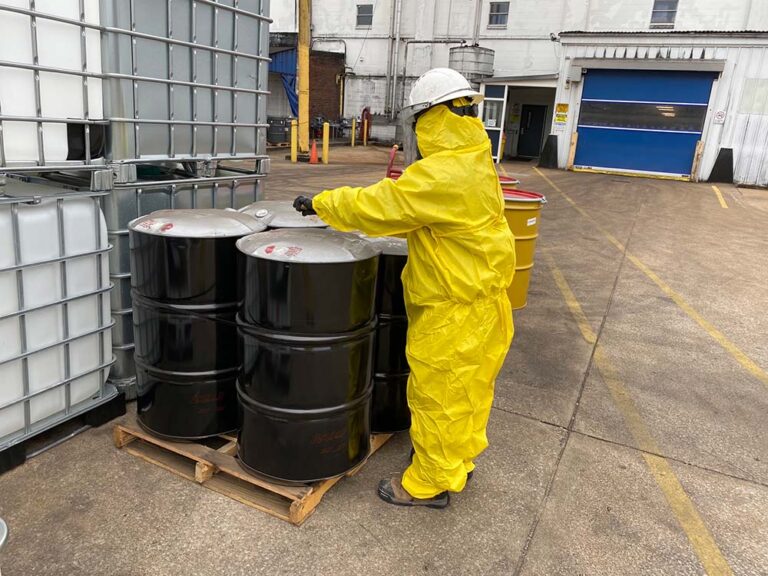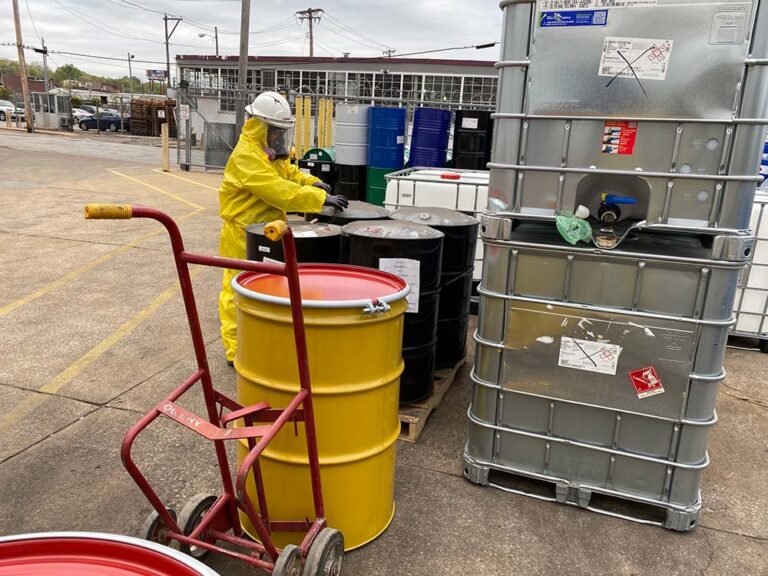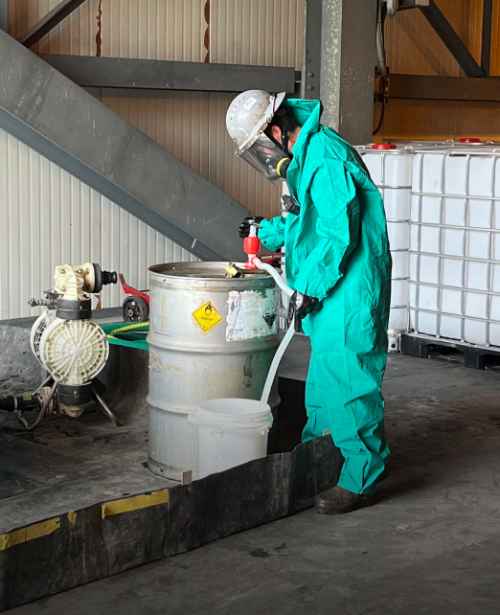Industrial and Hazardous Waste Disposal
Led by a team of RCRA and DOT trained technicians, our services include on-site hazardous categorization and segregation, profiling, manifesting, and transportation to qualified Treatment Storage Disposal Facilities (TSDFs). Based on the characterization of your waste streams, we determine which treatment method will best protect the health and safety of the people and environment. Common methods include:
- Subtitle C Hazardous Waste Landfill
- TSCA Landfill
- RCRA and/or TSCA Incineration
- Subtitle D Landfill
- Non-Hazardous Solidification
- Battery Recycling
- Explosives Management
- Chemical Oxidation and Stabilization
- Micro / Macro Encapsulation
- Fuel Blending
- Solid Waste Management
- Household Hazardous Waste Facility
- Universal Waste
- Beneficial Reuse
What is Industrial Waste?
Industrial waste is any material left over from the manufacture of goods that is no longer useful in the production process. There are several types of industrial waste, all of which are potentially damaging and require special handling in order to comply with state, local, and federal guidelines.

Non-Hazardous Waste
Even if a waste product does not pose any direct threat to health or the environment, it could contaminate the soil, water, or air if not properly managed. Common examples of non-hazardous waste include asphalt, rubber, ash, sludges, and carbonates.
Special Wastes
Solid wastes that are dangerous or difficult to manage at a landfill and pose a direct threat to human health and the environment. Cement kiln dust, unrefined petroleum, fly ash, and slag from lead and copper processing are common types of special wastes.
TSCA Waste
Congress passed the Toxic Substances Control Act (TSCA) in order to lessen the risks associated with industrial chemicals. There are 75,000 substances regulated by the act, including polychlorinated biphenyls (PCBs), asbestos, and lead-based paint.

What is Hazardous Waste?
Hazardous waste is any material that can potentially harm human health or the environment. Due to its dangerous chemical and physical characteristics, it requires special handling and disposal. Though most commonly associated with heavy industry, hazardous waste can come from many sources, including homes, businesses, and hospitals.
Characteristics of Hazardous Waste
According to the EPA’s Resource Conservation and Recovery Act (RCRA), solid waste is hazardous if it poses a threat in the absence of special regulation and is already on the EPA’s list of hazardous materials or if it exhibits at least one of four hazardous properties:
Ignitability
Flammable under certain conditions, can spontaneously ignite in the presence of air, or has a flash point of less than 60°C.
Corosivity
An acid or base capable of corroding metal such as a storage tank, drum, or metal container.
Reactivity
Explosive, emits toxic fumes, or reacts violently under normal handling conditions or when exposed to water.
Toxicity
Harmful or fatal when ingested or absorbed. Also runs the risk of leaching into the ground and damaging the environment.
Examples of Hazardous Waste
With our expertise and dedication to environmental preservation, we aim to assist industries in handling various types of hazardous waste responsibly and in compliance with regulations.
Listed Wastes
Listed wastes are specific types of hazardous waste that are identified by the U.S. Environmental Protection Agency (EPA) based on their manufacturing processes, industrial sectors, or other sources. These wastes are listed in four categories: F-listed wastes, K-listed wastes, P-listed wastes, and U-listed wastes. Each category encompasses different substances that pose potential harm to human health and the environment.
Characteristic Wastes
Characteristic wastes are hazardous wastes that exhibit specific characteristics such as ignitability, corrosivity, reactivity, or toxicity. These properties make them potentially harmful to human health and the environment. Identifying characteristic wastes is crucial to prevent contamination and to ensure their appropriate management.
Mixed Radiological Wastes
Mixed radiological wastes refer to hazardous materials that contain both radioactive and hazardous components. Proper management of such wastes is paramount to safeguard both public health and the environment. These wastes often originate from nuclear facilities, healthcare institutions, and research laboratories.
Hazardous Waste Management
Proper disposal of hazardous waste prevents contamination of the air, water, and soil. Hazardous waste should never be thrown into the regular trash or poured down the drain. Instead, it must be taken to a designated hazardous waste disposal facility, where it can be safely processed and disposed into carefully constructed units designed to protect soil and groundwater.
In the United States, hazardous waste regulation is managed by the Environmental Protection Agency (EPA). The EPA has established strict guidelines for the handling, transportation, and disposal of hazardous waste in order to ensure it is done safely and responsibly. This includes strict labeling and packaging requirements, as well as regulations to prevent spills and leaks during transportation. In addition, there may be state or even local regulations so it’s best to follow your local state and federal guidelines or partner with an expert that can help you stay compliant.
Consumers can play a role in reducing the amount of hazardous waste generated by properly disposing of household hazardous waste, such as batteries and electronics, at local recycling events. Businesses can also take steps to reduce their hazardous waste by properly managing their waste streams and reducing the use of hazardous materials.

Call O6 Environmental for Hazardous Waste Management

Hazardous waste must be carefully managed in order to protect people, communities, and the environment. Proper disposal protects the generator against expensive liability and prevents contamination. The EPA has laid down stringent regulations to ensure hazardous waste is handled and disposed of safely.
By being mindful of the waste we generate and taking steps to reduce and properly dispose of hazardous waste, we can help protect the environment for future generations. Contact O6 Environmental today to develop a hazardous waste program for your business.
Latest News

Company News, Environmental Remediation
Sediment and Sludge Removal: When It’s Required and How It’s Done SafelyWhy Sediment and Sludge Removal Matters Sediment and sludge buildup can interfere with system performance, ...
Read Article Managing Environmental Liability at Active Industrial Facilities
Managing Environmental Liability at Active Industrial FacilitiesUnderstanding Environmental Liability Environmental liability does not end once a facility is operational. Active industrial ...
Read ArticleTell Us Your Challenge. We’re Here to Assist.
"*" indicates required fields